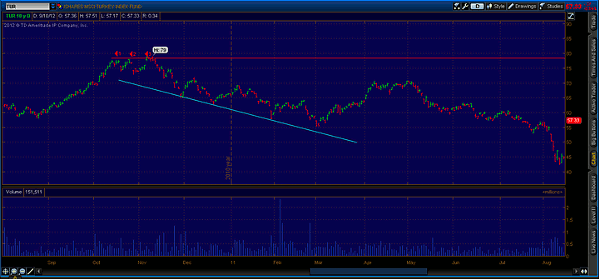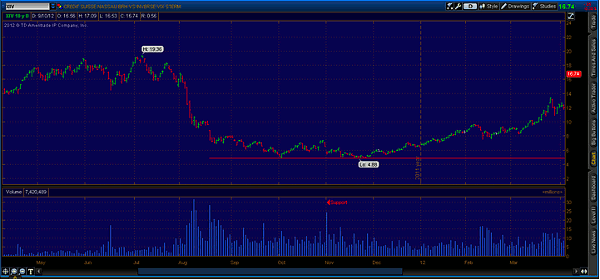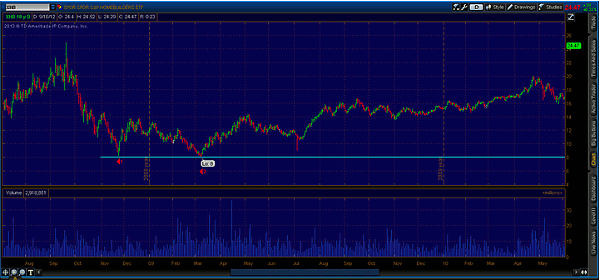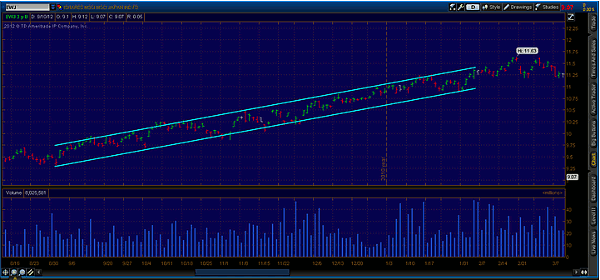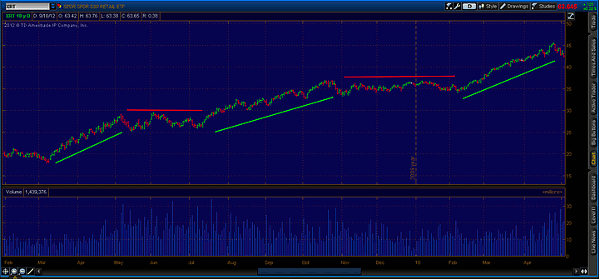Stoyan Bojinov, contributor to ETFdb.com, outlines five chart patterns that every ETF trader should recognize.
ETFs have found their way into countless portfolios, as the growing industry continues to spawn exciting and innovative products that encourage the democratization of the investment process. Thanks to the exchange traded product structure, self-directed investors can now easily tap into virtually any asset class from around the globe without breaking the bank or requiring specialized knowledge.
Aside from gaining traction among buy-and-hold investors, the trading community has also embraced ETFs thanks to their unparalleled transparency, cost efficiency, and intraday liquidity.
Active traders have come to utilize the ETF wrapper as the preferred means for establishing tactical exposure to any number of well-known benchmarks and asset classes. The ability to seamlessly move in an out of positions across virtually any corner of the market showcases the appeal of ETFs as viable trading vehicles for novices and professional money managers alike.
As more and more traders have come to use these tools, well-known technical analysis studies used in the equity market have carried over to ETFs. As such, below we offer an insightful look at five of the most common chart patterns that you should keep an eye out for.
Please note that the patterns highlighted below are observable over any period of time, from daytrading to a multi-month time frame, making them applicable for traders and investors alike.
5. Triple Top (or Triple Bottom)
This pattern is perhaps one of the most common, and ominous, in technical analysis, as it foreshadows a bearish trend reversal. In other words, a triple top is indicative of a prolonged uptrend coming to an end. This pattern is established when a given security sets three equal highs; notice how the 1, 2, and 3 marks on the chart below are all roughly at the same level.
In order for this pattern to be complete, the security must then break below support following its third attempt to break above the resistance level. The third bounce off the resistance level (red line) demonstrates that demand is drying out and bullish momentum is waning.
This chart pattern is also applicable in reverse; a triple bottom is established after the price fails to break below a given support level three times in a row and moves to rise past previous resistance, thus marking a bullish reversal.
If a security struggles to summit a certain resistance level for some time, be sure to keep a close watch, because a violent sell-off following a failed attempt could mark the beginning of a steep correction. Savvy traders can take advantage of this pattern set-up by entering into a short position near the triple top.
Next: Rounding Bottom
|pagebreak|4. Rounding Bottom
This chart pattern refers to a long-term bullish trend reversal. A rounding bottom can be identified by taking note of price movements that resemble the shape of a “U” following a downtrend.
In the example below, notice how the price of the security slows the rate at which it is falling significantly after the initial steep sell-off. The “rounding bottom” (prices near the red support line) represents a consolidation period during which longer-term investors enter the market as bullish sentiment slowly builds up.
Traders who notice a steep correction in a given security can keep an eye on it and take note of how it continues to move. If the prices continues to fall at a slowing rate and appears to be forming a saucer-like “U” shape, this may be a sign that a bullish trend reversal is around the corner.
3. Double Bottom
As the name implies, this chart patterns consists of two consecutive bounces off a given support level. This pattern bears a close resemblance to a “W” shape; first, a security drops and rebounds off a given level, and then it endures another drop which brings it back to the same level as it originally rebounded off.
In the example below, the twice-touched low is the blue support line. Similar to the triple top, this pattern is also applicable in reverse...a double top is established after the price fails to break above a given resistance level two times in a row and moves to fall below previous support, thus marking a bearish reversal.
When bargain shopping, investors can look to identify double bottoms in order to have more conviction prior to jumping in long in anticipation of a bullish trend reversal.
Next: Price Channel
|pagebreak|2. Price Channel
This chart pattern is formed when the price of a security continues to trend in a certain direction, whether its sideways, up or down, while at the same time being bound by an upper and lower trend line. The upper line marks resistance, while the lower line marks support.
The example below is a bullish price channel seeing as the prevailing momentum is positive, while the price of the security oscillates between support and resistance over a long time frame.
Traders can take advantage of a well-defined price channel by devising a disciplined strategy that looks to go long when a security is back near the bottom half of the channel, while at the same time taking profits (or selling short) when it rises to the upper resistance line of the channel.
1. Flag/Pennant
The flag or pennant chart pattern refers to the continuation of a trend interrupted by short-term periods of consolidation before the previous move resumes. This patterns is often characterized by sharp moves in either direction with heavy trading volume followed by a period of more or less sideways trading.
In the example below, the bullish flag/pennant is formed as the price rises sharply (green line) and enters into a narrow consolidation range (red line) before resuming the longer-term uptrend.
Traders who correctly identify this pattern can jump in long during the consolidation phase in anticipation that the security will sooner or later resume its uptrend and shoot higher.
Stoyan Bojinov is a contributor to ETFdb.com. Follow him on Twitter @SBojinov.

